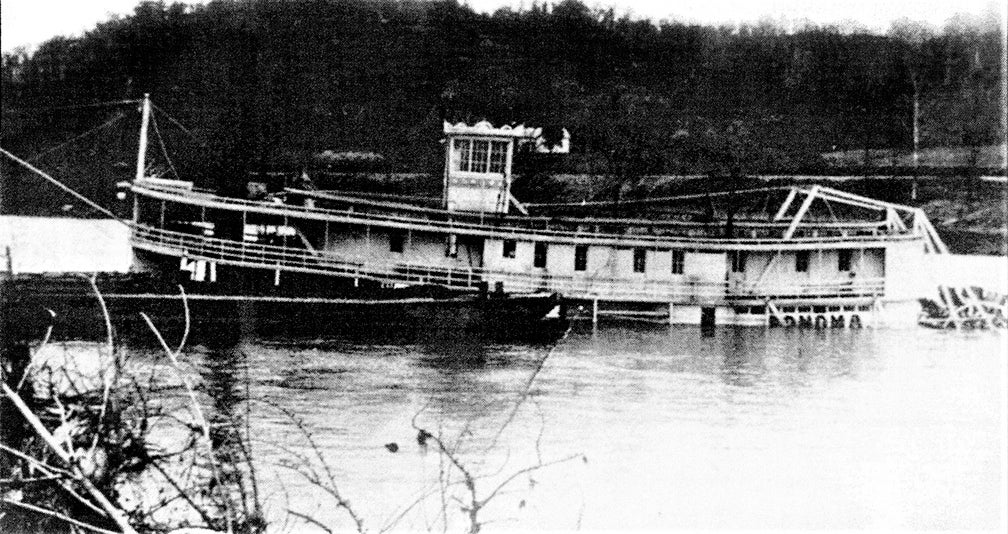From 1820 to 1930, Frankfort was connected to the outside world by steamboats. During the 19th century, these steam sternwheel packet boats carried goods from Frankfort to markets as distant as New Orleans, Louisiana and Fort Benton, Montana. However, by the beginning of the 20th century, these steamboat packets had lost the long-distance trade to the railroads.
The first three decades of the 20th century saw this river trade reduced to twice weekly packet boat service between Frankfort and Madison, Indiana. These boats called at the towns of Carrollton, Lockport, Gratz and Monterey as they steamed up the Kentucky River for Frankfort. Along the way, they also stopped at any riverbank landing where they were signaled to stop by a person who wished to board or for which the boat had goods to deliver.

In 1913, the packet boat Sonoma hit a snag and sank to the bottom of the Kentucky River. (Photo submitted)
The packet boats were also used by men and women who wished to visit Frankfort for various reasons and by the citizens of Frankfort to enjoy an overnight outing to Madison or to visit riverbank friends. Among the packet boats that during 1913 offered twice weekly sailings between Frankfort and Madison was the Sonoma.
Sonoma was built in 1881 at Harmar, Ohio, as a wooden hull sternwheel packet boat. Upon completion, she was 115-feet long with a beam of 20-feet and, when fully loaded, had a draft of but 3-feet. Owned first by Captain Edmund Cooper, Sonoma, during the 1880s, ran in the Upper Ohio River trade before moving to the Big Sandy River. With the completion of the Chesapeake & Ohio Railway from Catlettsburg, Kentucky, to Pikeville, Kentucky, Sonoma returned to the Upper Ohio River trade.
In 1897, Sonoma was lengthened to 20.5-feet. Circa 1910, she began to trade on the Muskingum River. On April 19, 1911, while in this trade, she hit a snag and sank in the Ohio River. She was salvaged shortly thereafter. In 1913, Sonoma, now owned by Captain E. W. Webster, entered the Kentucky River trade. Twice a week she made a round trip voyage between Madison and Frankfort transporting passengers and cargo.
The voyage from Madison to Frankfort via the Kentucky River, which consisted of locking through locks and dams numbers one to four, was advertised as one of America’s most scenic river routes.
On Saturday, May 3, 1913, Sonoma sailed from Madison bound for Frankfort. She was under the command of Captain Webster and was fully loaded with a cargo of goods destined for Frankfort and various towns and landings along the way. She was also carrying a load of passengers.
Sonoma’s first stop was Carrollton where she dropped off and picked up cargo and passengers. From Carrollton, the boat headed up the Kentucky River making stops at landings on both riverbanks. At this time, the river was high and running fast as a result of upstream heavy rains. Various types of debris were being propelled downstream by the river’s swift current. Sonoma had to struggle as she forced her way upstream against the free-flowing current
Among the passengers on board Sonoma on May 3, 1913, were Mrs. B. F. Kidwell, who was taking a pleasure trip to Frankfort, and John and Ann Crawford who, with their three children, a girl age 1 and two boys ages 8 and 10, were bound for Lockport. The one-year-old baby was placed on the bed in a cabin after they had boarded Sonoma.
At Lower Beechwood Landing, located two miles above Drennon Creek in Henry County, Captain Webster, in response from a signal from ashore, turned Sonoma toward the bank to pick up a passenger. As Sonoma approached the riverbank, she hit a snag, which tore a gaping hole in her hull and Sonoma quickly took on water.
The inrushing water caused her deck cargo to shift resulting in her capsizing; Sonoma sank upside down to the bottom of the Kentucky River. Two lives were lost in the sinking, Mrs. B. F. Kidwell and the Crawford’s baby daughter, both being trapped in their cabins as the boat turned over and went down.
While various attempts were made to salvage Sonoma and her cargo, all met with failure. The bodies of the two drowning victims, however, were recovered. To clear the Kentucky River navigation channel, the Corps of Engineers dynamited the wreck. There is no account if any citizens of Frankfort were on board Sonoma when she sank or what cargo various merchants of Frankfort lost in this sinking. Some metal remains of Sonoma still lie in the Kentucky River waiting for some 22nd century archeologist to discover theses artifacts.
For those interested in lost treasures, the purser’s safe that was onboard Sonoma when she sank was not recovered during the attempted salvage operation. Each year, with the retelling of the tale of the sinking of Sonoma, the amount of gold and silver in this safe grows by ten-fold.
The Capital City Museum is always seeking artifacts that tell the story of Frankfort’s relationship with the Kentucky River.










